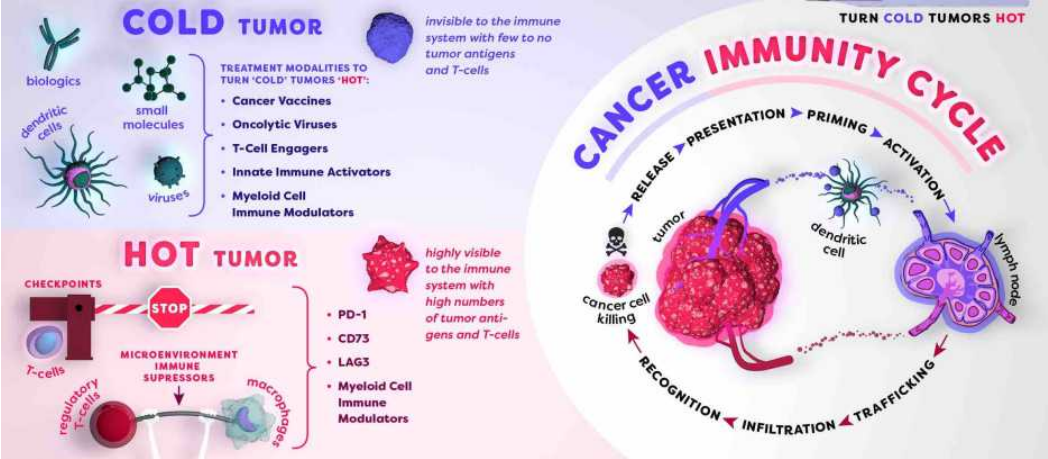Enhance and maintain the body's immune anti-cancer capacity, inhibit or eliminate the formation and progression of cancer cells, implement immune prevention and immune regulation, convert "cold tumors" into "hot tumors", achieve immune balance, and ultimately control cancer.

Therapies and Mechanisms
Enhance and maintain the body's immune anti-cancer capacity, inhibit or eliminate the formation and progression of cancer cells, implement immune prevention and immune regulation, convert "cold tumors" into "hot tumors", achieve immune balance, and ultimately control cancer.
DC-T Cell Therapy
Dendritic cells (DCs) are important antigen-presenting cells. Tumor antigens are released (after radiotherapy or ablation therapy), taken up by DCs, transported to lymph nodes, and presented to T cells.T cells then infiltrate into the tumor, recognize the tumor cells, and kill them. The killed tumor cells release antigens, which are again taken up by DCs, thus forming an "anti-cancer cycle". Professor Xu Kecheng has reported relevant clinical studies since 2013 (Cryobiology.2013;67(2):235; Immunol Let.2017 Mar;183:37-43).
Natural killer,NK Therapy
NK cells are a type of innate cells that do not require any stimulation (antigen activation). They attack and kill enemies upon encounter, and can clearly distinguish between self and non-self, leaving the body's normal cells unharmed. The cells killed by NK cells mainly include cancer cells (regardless of type), cells infected by bacteria or viruses, and senescent cells. Therefore, NK cells can not only fight cancer but also resist infections and delay aging (since senescent cells release inflammation, clearing them is equivalent to anti-inflammation, which is beneficial to health). Professor Xu Kecheng and his colleagues have published several studies since 2017 (Immunol Lett.2017;191:10; J Cancer Res Clin Oncol. 2017;143:2607; Cardiovasc Intervent Radiol. 2019;42(1):48).
Gamma-delta T Cell Therapy
Itis also a type of innate immune cell. Though small in number within the T cell population, it is brave and effective in combat. It can actively kill enemies "without stimulation" like NK cells, and can also specifically kill cancer cells under antigen stimulation like T cells. Professor Yin Zhinan took the lead in successfully completing the cultivation research of allogeneic Gamma-Delta T cells in China. Professor Xu Kecheng and Dr. Alnaggar M were the first in the world to successfully treat a Hungarian patient with liver cancer using allogeneic gamma-delta T cells, and relevant articles have been published (J Immunother Cancer; 2019; 7:36; Cell Mol Immunol.2021;18(2):427-439.).
Novel cancer complex immunotherapy
Immune cells (especially T cells and NK cells) often need "stimulation" to kill cancer cells. Many substances, such as bacterial and viral death products and some chemical substances, are called immune adjuvants, which can not only enhance immune responses but also enable the body to obtain optimal protective immunity. The Cancer Composite Immunomodulator (Ccl) is a multi-target stimulant composed of various biological and chemical adjuvants, capable of activating multiple anti-cancer immune mechanisms. It was developed by renowned tumor immunology experts such as Academician Wang Zhenyi and Professor Xu Kecheng, with the invention patent number 20o91oo51734.1.There have been many successful cases, and relevant papers have been published in Onco Targets Ther.2019;12:2531 and Clin Surg 2022,Mar.
Toll-like receptors (TLRs) are pattern recognition receptors widely expressed on various innate immune cells such as dendritic cells, macrophages, and NK cells. When certain agonists bind to these receptors, they can stimulate the innate immune system and activate the body to produce anti-tumor immune cell responses. It has been proven that composite immunomodulators may exert anti-cancer effects by activating TLRs.
Immune Checkpoint Blockade (ICB)Therapy: Anti-PD-1/PDL1
Immune cells, mainly T cells, have an immune checkpoint called PD-1 on their surface, while cancer cells have ligands such as PD- L1 or PD-L2 on theirs. When the immune checkpoint binds to its ligand, T cells become "immobilized" and ineffective. The use of anti-PD-1 or anti-PD-L1 drugs can disrupt this "binding", thereby releasing T cells and enabling them to kill cancer cells.
Cancer Stem Cell Vaccine
A unique type of cancer stem cells (Cscs) exists in tumors. These cells are resistant to traditional chemotherapy and radiotherapy, and have been associated with tumor recurrence and metastasis. The use of cancer stem cells with high immunogenic expression as an antigen source to induce protective anti-tumor immunity has been proven to significantly inhibit tumor growth, prevent tumor metastasis, and prolong patient survival. Scholar Li Qiao from the University of Michigan in the United States has successfully completed relevant research and introduced nanotechnology into this treatment. As early as 2015, Professor Xu Kecheng and his colleagues published clinical studies on the safety and effectiveness of cancer stem cell vaccines in lung cancer and nasopharyngeal cancer (Immunol Res.2015;62:16;Immunol Lett.2015;165:26;JCancer Res Clin Oncol. 2015;141:1827).
Tumor Infiltrating Lymphocyte (TIL) Therapy
Tumor-Infiltrating Lymphocyte (TIL) Therapy utilizes the patient's own immune cells to attack tumor cells, featuring high specificity and safety. In 2024, the U.S. FDA approved a TIL therapy named Amtagvi (lifileucel) for the treatment of unresectable or metastatic melanoma. TIL therapy has also shown promising efficacy and potential in treating solid tumors such as lung cancer, breast cancer, and head and neck cancer. In clinical studies on gynecological tumors including ovarian cancer, cervical cancer, and endometrial cancer, the disease control rate (DCR) reached 84.2%.


 (+86)18613012387
(+86)18613012387 info@royallee.cn
info@royallee.cn EN
EN CN
CN TH
TH IDN
IDN  AR
AR


